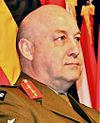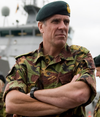The New Zealand Defence Force is the three-branched military of New Zealand. The NZDF is responsible for the protection of the national security of New Zealand and her realm, promoting its interests, safeguarding peace and security, as well as supporting peacekeeping and humanitarian missions. It consists of three services: the Royal New Zealand Navy (RNZN), the New Zealand Army and the Royal New Zealand Air Force (RNZAF), as well as 'tri-service' components. As of June 2023, the NZDF has a strength of 14,996 employees, consisting of 8,669 regular force personnel, 3,260 reserve force personnel and 3,067 civilian members. It is supported by the New Zealand Ministry of Defence (MOD) and is commanded by the Chief of Defence Force (CDF).
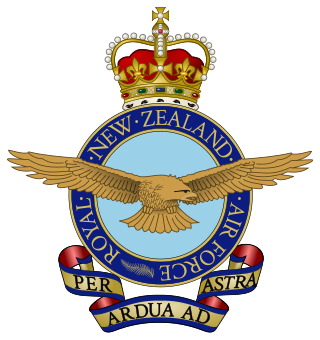
The Royal New Zealand Air Force is the aerial service branch of the New Zealand Defence Force. It was formed initially in 1923 as a branch of the New Zealand Army, being known as the New Zealand Permanent Air Force, becoming an independent air force on 1 April 1937.

A commander-in-chief or supreme commander is the person who exercises supreme command and control over an armed force or a military branch. As a technical term, it refers to military competencies that reside in a country's executive leadership, a head of state, head of government, or other designated government official.
Air marshal is an air-officer rank used by some air forces, with origins from the Royal Air Force. The rank is used by the air forces of many countries which have historical British influence, including many Commonwealth nations. The rank is usually equivalent to a vice admiral or a lieutenant general.

Flight sergeant is a senior non-commissioned rank in the Royal Air Force and several other air forces which have adopted all or part of the RAF rank structure. It is equivalent to a staff sergeant or colour sergeant in the British Army, a colour sergeant in the Royal Marines, and a chief petty officer in the Royal Navy, and has a NATO rank code of OR-7. In the RAF, flight sergeant ranks above chief technician and below warrant officer.
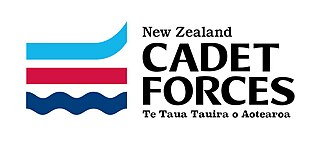
The New Zealand Cadet Forces is a voluntary military-style training organisation for New Zealand youth between the ages of 13 and 21. Run in partnership with the New Zealand Defence Force (NZDF) and local community organisations. Through its three branches, the New Zealand Cadet Forces provide young adults with a four-year training curriculum, while a number of local, area, and national camps and courses provide further experience and qualifications. It is jointly funded by the Ministry of Defence, the Royal New Zealand Returned Services' Association, local communities, and the Associated charities belonging to each branch. Overall it is directed by Air Marshal Kevin Short, Chief of Defence Force. Cadets are not under any obligation to join the New Zealand Defence Force, however many choose to do so upon turning 18 years old.

Air Chief Marshal Sir Allan Grant "Angus" Houston, is a retired senior officer of the Royal Australian Air Force. He served as Chief of Air Force from 20 June 2001 and then as the Chief of the Defence Force from 4 July 2005. He retired from the military on 3 July 2011.

Admiral Christopher Alexander Barrie, is a retired senior officer of the Royal Australian Navy, who served as Chief of the Defence Force from 4 July 1998 to 3 July 2002.
The Ministry of Defence is the public service department of New Zealand responsible for advising the government on strategic defence policy, acquiring military equipment to meet defence capability and conducting audits and assessments of the New Zealand Defence Force.

Chief of Air Force (CAF) is the most senior appointment in the Royal Australian Air Force (RAAF), responsible to the Chief of the Defence Force (CDF) and the Secretary of the Department of Defence. The rank associated with the position is air marshal (three-star). The role encompasses "the delivery of aerospace capability, enhancing the Air Force's reputation and positioning the Air Force for the future". It does not include direction of air operations, which is the purview of the Air Commander Australia, a two-star position responsible directly to CDF in such circumstances but nominally reporting to CAF.

The Chief of the Defence Force (CDF) is the highest-ranking and most senior military officer in the Australian Defence Force (ADF) and is the principal military advisor to the National Security Committee and the Minister for Defence. The current Chief of the Defence Force is General Angus Campbell, who took office on 6 July 2018.

The Chief of Navy is the most senior appointment in the Royal Australian Navy, responsible to the Chief of the Defence Force (CDF) and the Secretary of Defence. The rank associated with the position is vice admiral (3-star).

The Vice Chief of the Defence Force (VCDF) is the military deputy to the Chief of the Defence Force (CDF) of Australia, and acts as the CDF in his absence under standing acting arrangements. Vice Admiral David Johnston, the incumbent VCDF, has held the position since 5 July 2018.

The Chief of Defence Force is the head of the Singapore Armed Forces (SAF), who holds the rank of Lieutenant-General or Vice-Admiral. The Chief of Defence Force also serves as the aide-de-camp to the president of Singapore. The current Chief of Defence Force is Aaron Beng.

Lieutenant General Timothy James Keating is a former New Zealand Army officer and Chief of the New Zealand Defence Force. He was appointed Chief of Defence Force in 2014, immediately following his tenure as Vice Chief of Defence Force. He served as Chief of Army from 2011 to 2012.

Chief of Army (CA) is the effective commander of the New Zealand Army, responsible to the Chief of Defence Force (CDF) for raising, training and sustaining those forces necessary to meet agreed government outputs. The CA acts as principal advisor to the CDF on Army matters, though for operations the Army's combat units fall under the command of the Land Component Commander, Joint Forces New Zealand. The rank associated with the position is major general, and CAs are generally appointed on a three-year term.
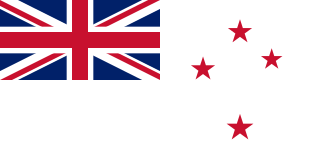
Chief of Navy (CN) commands the Royal New Zealand Navy (RNZN) and is responsible to the Chief of Defence Force (CDF) for raising, training and sustaining those forces necessary to meet agreed government outputs. The CN acts as principal advisor to the CDF on Navy matters, and is the most senior appointment in the RNZN. The rank associated with the position is rear admiral, and CNs are generally appointed on a three-year term.

Air Marshal Kevin Ronald Short, is a retired Royal New Zealand Air Force officer. He served as Chief of Defence Force from 1 July 2018 to 6 June 2024.

The Chief of the Defence Forces is the professional head of the Malaysian Armed Forces and the most senior uniformed military adviser to the Yang di-Pertuan Agong, the Prime Minister and the Minister of Defence. The CDF is based at Wisma Pertahanan, Kuala Lumpur, nearby to the Ministry of Defence. The CDF is the highest rank in Malaysia Armed Forces only after the YDPA which holds the title Commander-in-Chief.
Rose King is a New Zealand army officer and the first woman career soldier in New Zealand to be promoted to the rank of brigadier. She was in the Royal New Zealand Electrical and Mechanical Engineers Corps, and in 2021 was appointed joint head of managed isolation and quarantine (MIQ) in New Zealand.







